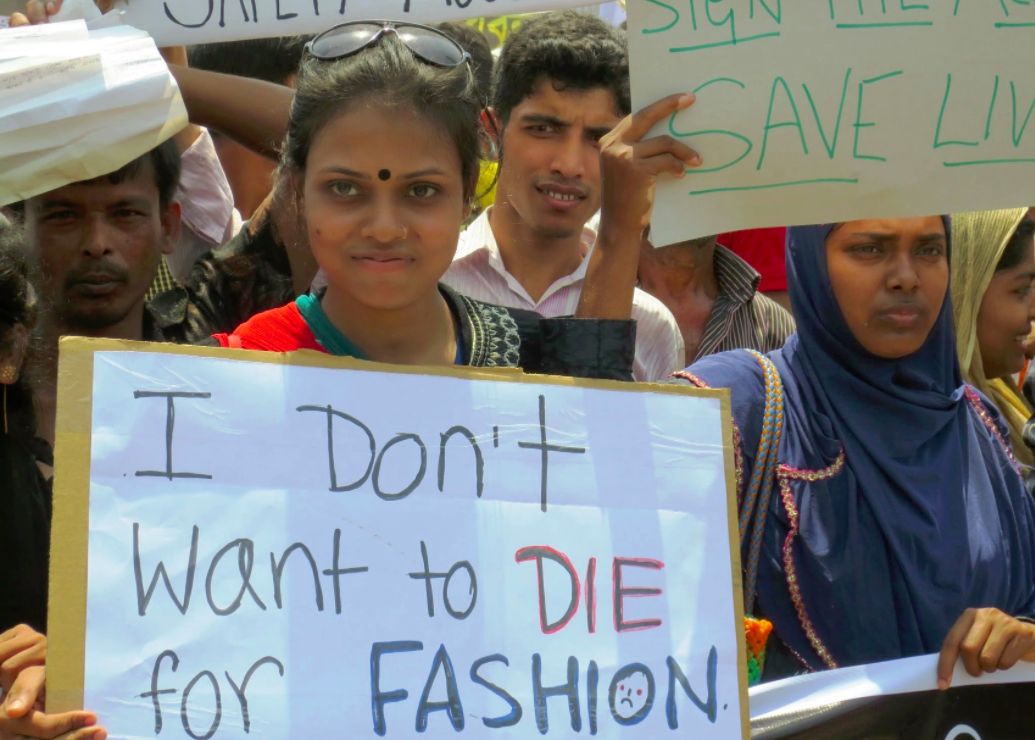The fashion industry's dirty laundry
With London Fashion Week wrapping up today, it’s got me thinking about the current state of the fashion industry. While I’m still madly in love with the creativity and innovation of creating garments, I have become very disillusioned by the way consumerism has cheapened the industry. I sometimes feel that we’re campaigning more than ever against the fast fashion system, but yet it keeps growing bigger and bigger and nothing we do can slow it down. It might sound defeatist, but some days I struggle to see a time where we will learn from our mistakes and learn to live with less.
A lot of conversations I have with people about fashion lead to me bringing up how bad fast fashion is and why I’ve chosen to only shop second hand or from ethical brands. I’m constantly reading news articles about new reports into the fashion industry, exposing their hidden secrets and shining a light on the consequences of this fast fashion structure. Most of the time I learn a new fact or statistic that I didn’t know before and it gives me a renewed passion for fighting against the system.
If more people knew these facts would they be more willing to look at their own shopping habits and consider making some changes? Could we win this battle by spreading a heightened awareness of the impact our shopping choices have on the world around us? Well, if it’s worth a shot in hell then it’s worth a blog post. So here are 3 facts that the fashion industry hopes you don’t find out! Have a read and see what resonates with you, and let’s air out some of their dirty laundry…
social inequality
Bangladesh garment workers make just 18% of the living wage needed to pay for housing, food, clothing, education, transport and healthcare. To put this into perspective, imagine you live in rented accommodation in Bristol and you need at least £1,500 a month to be able to afford your rent, bills, food, transport, etc. Now imagine you only get paid £270 a month. It’s not doable is it?
In the global garment industry approximately 80% of garment workers are women, aged 18-35, and they are often the main income earner and raising children. They are working for next to nothing because these jobs are the only option available to them. This is the result of fast fashion; cheap garments made in horrible working conditions by women who don’t make enough money to live on. Child labour is still a huge issue as well; don’t be fooled to think that’s a thing of the past. The ILO estimates that 170 million are engaged in child labour, with many making textiles and garments to satisfy the demand of consumers in Europe, the US, and beyond.
What can you do about it?
Ask brands #whomademyclothes and demand transparency of their production chain. Lessen your individual demand on the fashion industry by shopping second hand and generally buying less than you usually do, and encourage others to do the same!
environmental impact
The fashion industry produces 10% of all humanity's carbon emissions, and is the second-largest consumer of the world's water supply. Carbon emissions and water usage are two of the worst offenders for environmental impact, and they’re involved at every stage of garment production. From growing crops, and dying textiles, to transporting every element of a garment to a factory to put it all together.
It’s not just the environmental impact of producing all these textiles; it’s also the impact of how fast we throw them away too. In total, up to 85% of textiles go into landfills each year, that's enough to fill the Sydney harbour annually. We like to think that when we donate clothes to charity, they will get a new lease of life and be valued by someone else, but in reality most of what we donate ends up being shipped to countries around the world to be ripped apart and turned into “shoddy” fabric.
What can you do about it?
Opt for organic cotton when buying new clothing – its much less water and energy intensive and doesn’t use nasty chemicals to grow. Avoid buying cheaply made clothing that’s more likely to break, try and invest in pieces you really need/want that you will love for a lifetime.
animal welfare
Leather is not simply a by-product of the meat industry, but an in-demand product that helps keep the meat industry in business. When you buy cow’s leather products, you are actively supporting the cruel leather trade that supplies it. Most of the world’s leather comes from China and India, where there are little to no animal welfare laws, meaning factory-farmed cows are raised, transported and eventually killed under unsafe and even torturous conditions.
Wool has also slipped by unnoticed as an unsustainable and unethical product. Sheep require a lot of land to be raised on and actually damage the soil they stand on, making it impossible to grow anything after they graze (look up sheep irrigation). Sheep are often put through the horrific and ineffective process of mulesing where flesh is cut from their backside with no anaesthetic, and the shearing process is often cruel and inhumane due to shearers getting paid per sheep not per hour.
What can you do about it?
Buy vegan fashion! Only vegan clothing can guarantee that no animal has been harmed or killed to create your clothes. But watch out for the synthetics, not all are a better option, try and opt for natural, animal-free fabrics like hemp, organic cotton, bamboo, Tencel, and linen.
So, now you’re armed with the facts (well, some of them), go forth and spread the truth and let’s get all this dirty laundry out in the open! #grandermarnier



